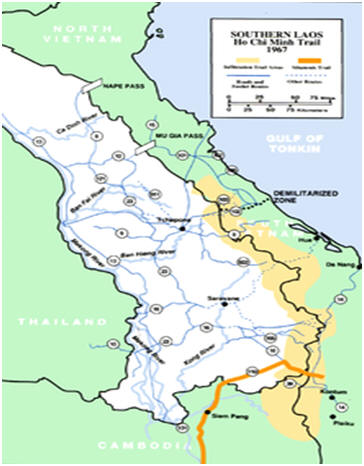
The Ho Chi Minh Trail Running through Laos, 1967

Washington encouraged its SEATO allies to contribute troops. Australia, New Zealand, the Republic of Korea, Thailand, and the Philippines all agreed to send troops. Major allies, however, notably NATO nations Canada and the United Kingdom, declined Washington's troop requests. The U.S. and its allies mounted complex operations, such as operations Masher, Attleboro, Cedar Falls, and Junction City. However, the communist insurgents remained elusive and demonstrated great tactical flexibility.
Meanwhile, the political situation in South Vietnam began to stabilize with the coming to power of Prime Minister Air Marshal Nguyễn Cao Kỳ and figurehead Chief of State, General Nguyễn Văn Thiệu, in mid 1965 at the head of a military junta. This ended a series of coups that had happened more than once a year. In 1967, Thieu became president with Ky as his deputy, after rigged elections. Although they were nominally a civilian government, Ky was supposed to maintain real power through a behind-the-scenes military body. However, Thieu outmaneuvered and sidelined Ky by filling the ranks with generals from his faction. Thieu was also accused of murdering Ky loyalists through contrived military accidents. Thieu, mistrustful and indecisive, remained president until 1975, having won a one-man election in 1971.
The Johnson administration employed a "policy of minimum candor" in its dealings with the media. Military information officers sought to manage media coverage by emphasizing stories that portrayed progress in the war. Over time, this policy damaged the public trust in official pronouncements. As the media's coverage of the war and that of the Pentagon diverged, a so-called credibility gap developed.